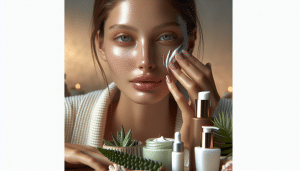Glow Secrets You’ve Never Heard For Radiant Skin
Natalie Brooks September 24, 2025
Explore surprising wellness approaches and beauty rituals that support a luminous complexion from the inside out. Learn how skincare routines, nutrition, hydration, and emerging science contribute to naturally radiant skin with practical, realistic guidance for healthier beauty every day.
The Science Behind Natural Skin Radiance
Radiant skin is often a reflection of overall health as much as targeted beauty routines. Recent research shows how genetics, lifestyle, and environment all influence complexion. Some people may be predisposed to a glowing appearance naturally, but most individuals can activate those traits with strategic daily choices. Unlocking skin luminosity starts with understanding how hydration, nutrition, and cellular renewal work together.
The skin barrier, or stratum corneum, plays a pivotal role in maintaining moisture and protecting against environmental stressors. A well-functioning barrier keeps water inside the skin, creating a plump, glowing effect, while also locking out irritants and pollutants (Source: https://www.aad.org/public/everyday-care/skin-care-basics/dry/keep-skin-moisturized). Everyday factors like harsh weather, pollution, and even stress can disrupt this delicate system, reducing your natural glow.
A skincare routine rooted in science can help restore and preserve skin radiance. Consistent cleansing, gentle exfoliation, and adequate moisturizing provide a strong foundation. Many individuals benefit from layering antioxidants such as vitamin C, which combats free radical damage caused by UV exposure and urban living (Source: https://www.ncbi.nlm.nih.gov/pmc/articles/PMC5579659/). Small shifts in everyday habits—like double cleansing in the evening—may also make a difference over time.
Nutrition That Brightens Your Complexion
The connection between what you eat and how your skin appears is stronger than many realize. Certain nutrients can support collagen production, bolster hydration, and strengthen the skin’s resilience. Diets rich in colorful vegetables, fruits high in antioxidants, and omega-3 fatty acids play a recognized role in skin health. For instance, dark leafy greens provide vitamin A, which supports cellular turnover for a visibly fresher look (Source: https://www.hsph.harvard.edu/nutritionsource/vitamins/vitamin-a/).
Omega-3 fatty acids, found in walnuts, chia seeds, and oily fish, help reduce inflammation and maintain the skin’s structural integrity. Lower inflammation can mean fewer flare-ups and a more even complexion, which often translates to a subtle, healthy luminosity. Zinc from sources like pumpkin seeds and beans also plays an important role in skin repair and regulation of oil production.
Focus on fermented foods and probiotics for smoother texture and fewer blemishes. Recent findings suggest the gut-skin axis is real—supporting digestive wellness may positively influence the way skin retains moisture and defends itself against irritation (Source: https://www.ncbi.nlm.nih.gov/pmc/articles/PMC8247682/). Swapping sugary drinks for green tea or water infusions can offer antioxidant support with every sip.
Hydration Strategies For a Lasting Glow
Hydration, inside and out, is at the heart of a healthy complexion. While topical moisturizers protect the skin barrier, true skin radiance often starts with internal hydration. Drinking enough water consistently isn’t just a wellness cliché—it genuinely impacts skin cell function, firmness, and reflectivity. The precise amount each individual needs varies, but visible benefits arise when daily intake supports the body’s needs (Source: https://www.cdc.gov/healthyweight/healthy_eating/water-and-healthier-drinks.html).
Topical hydration comes in many forms. Humectants such as hyaluronic acid and glycerin hold water at the skin’s surface, leaving it softer and more luminous. Occlusives, like shea butter and squalane, seal that hydration in. Layering these products correctly—humectants first, then occlusive—is often recommended for those with dry or combination skin types. These steps may be a secret behind the “glass skin” trend circulating in global beauty conversations.
Humid environments can support hydrated, dewy skin effortlessly, but not everyone lives in a moisture-rich climate. Using a bedside humidifier during dry months, especially while sleeping, helps maintain moisture balance overnight. Even subtle changes in indoor air quality can make a tangible difference, ensuring your glow isn’t limited to vacations or summer.
Sleep and Stress Management for Skin Wellness
The quality of your sleep has a profound impact on your facial appearance. Research links consistent, sufficient rest with accelerated skin cell turnover and repair. Melatonin, released during deep sleep, is involved in both anti-aging and cellular renewal processes, promoting overnight glow (Source: https://www.sleepfoundation.org/physical-health/how-sleep-affects-your-skin). Poor sleep, on the other hand, may lead to a dull or uneven texture as cells struggle to regenerate efficiently.
Stress triggers a surge of cortisol, the stress hormone, which can prompt inflammation and breakouts. Chronic stress may even break down collagen and elastin, key proteins responsible for plumpness and elasticity. Mindful practices—like gentle stretching before bed or guided meditation—help regulate these responses. Over time, this offers a pathway to both emotional well-being and skin clarity.
Finding sleep-friendly routines can make a lasting difference. Soft lighting, limited screen exposure in the evening, and soothing herbal teas can create the right environment for restorative sleep. Consider journaling or gratitude practices to release mental tension, which in turn may reveal a more luminous complexion after a few restorative nights.
Smart Skincare Steps That Truly Work
Building an effective skincare routine involves products, timing, and technique. Experts agree that “less is more” when starting out. Cleansing morning and evening removes buildup and excess oil without stripping protective skin layers. Following immediately with a gentle toner and antioxidant serum—such as those containing vitamin C or niacinamide—can help even skin tone and enhance the reflection of light off the skin, visibly increasing radiance.
Sun protection is non-negotiable for lasting glow. Daily broad-spectrum sunscreen with SPF 30 or higher, even on cloudy days, prevents photoaging and hyperpigmentation (Source: https://www.skincancer.org/healthy-lifestyle/skin-care/importance-of-sunscreen/). Layering sunscreen with antioxidant-rich products may further support natural brightness, helping offset environmental damage from both UV and pollution.
Adding in treatments like occasional exfoliation clears away dead surface cells, encouraging new ones to reflect light. For sensitive types, weekly enzymatic masks using fruit acids can achieve gentle resurfacing. A holistic approach might also explore facial massage, which boosts circulation and creates an immediate effect—subtle, but often enjoyed by many after a long day.
Emerging Trends in Beauty and Skin Wellness
Cutting-edge research continually expands the beauty landscape. Peptides, microbiome-balancing skincare, and adaptogen-infused serums are making their mark on routines worldwide. Some individuals are turning to light therapy, which uses certain wavelengths to address concerns like dullness, mild acne, or inflammation. Science is still evolving, but these treatments have earned cautious endorsement for their visible, if sometimes modest, improvements (Source: https://www.ncbi.nlm.nih.gov/pmc/articles/PMC4126803/).
The beauty world is also embracing holistic principles—combining mental, physical, and emotional wellness in pursuit of authentic radiance. Mindful beauty includes self-care routines, regular movement, and digital detoxes. This full-body approach suggests that true glow is a blend of internal health, emotional balance, and savvily chosen skincare steps. Tracking progress through journaling or photos helps many discover what truly works for lasting luminosity.
Sustainable and eco-friendly beauty is on the rise as well. Conscious consumers seek out products with minimal packaging, refillable designs, and cruelty-free sourcing. This trend reflects an awareness that luminous skin can coexist with environmental harmony, redefining what it means to truly glow, inside and out.
References
1. American Academy of Dermatology. (n.d.). How to keep your skin hydrated. Retrieved from https://www.aad.org/public/everyday-care/skin-care-basics/dry/keep-skin-moisturized
2. Pullar, J.M., Carr, A.C., & Vissers, M.C. (2017). The roles of vitamin C in skin health. Nutrients, 9(8), 866. Retrieved from https://www.ncbi.nlm.nih.gov/pmc/articles/PMC5579659/
3. Harvard T.H. Chan School of Public Health. (n.d.). Vitamin A. Retrieved from https://www.hsph.harvard.edu/nutritionsource/vitamins/vitamin-a/
4. CDC. (n.d.). Water and healthier drinks. Retrieved from https://www.cdc.gov/healthyweight/healthy_eating/water-and-healthier-drinks.html
5. Sleep Foundation. (n.d.). How sleep affects your skin. Retrieved from https://www.sleepfoundation.org/physical-health/how-sleep-affects-your-skin
6. Gold, M.H. (2014). The role of light therapy in skin revitalization. Journal of Clinical and Aesthetic Dermatology, 7(7), 23-30. Retrieved from https://www.ncbi.nlm.nih.gov/pmc/articles/PMC4126803/








